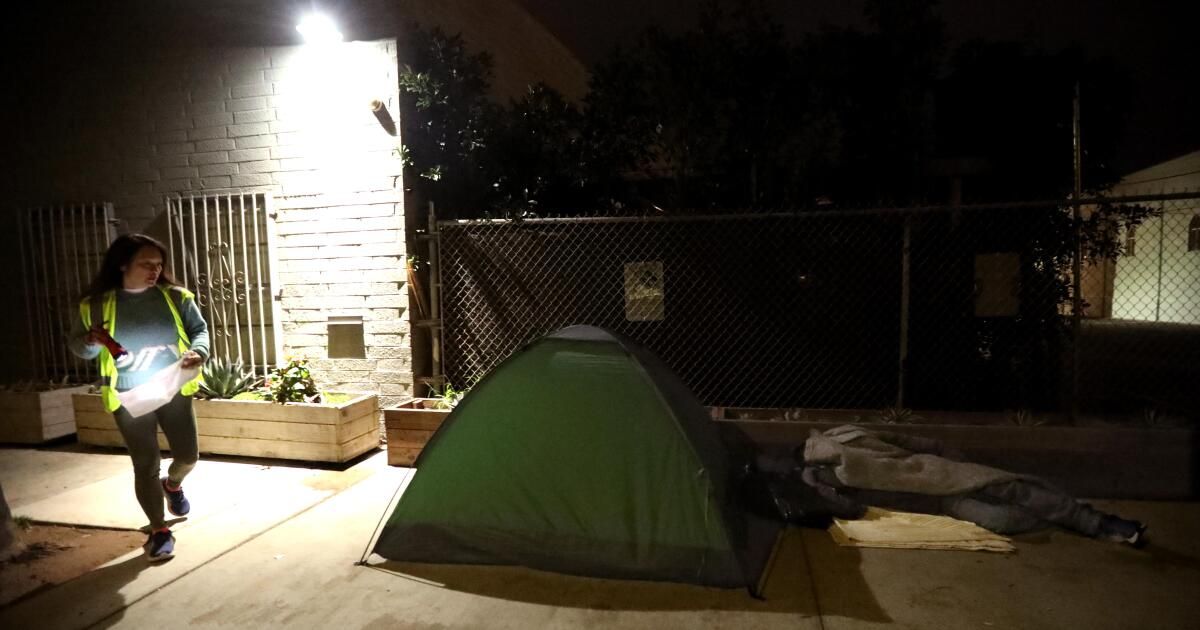Finally, homeless numbers in the city of Los Angeles are trending in the right direction.
Results from the 2024 homeless count released Friday show a 2.2% drop in the population of homeless people living in the city of Los Angeles, from 46,260 in 2023 to 45,252. It's not a huge difference, but it's noteworthy and encouraging, especially considering the 2023 figure is up 10% from 41,980 in 2022.
No problem in the county and city of Los Angeles has been more complicated, costly and distressing than trying to house and assist the tens of thousands of people who find themselves living on sidewalks and in shelters. So it’s encouraging to see that the strategy employed by Los Angeles Mayor Karen Bass appears to be working.
Its Inside Safe program focuses on moving people from encampments across the city into temporary housing, primarily in the form of hotels and motels, but also tiny homes. The county has a similar interim housing program called Pathway Home and also provides services to homeless people living in temporary and permanent housing.
Meanwhile, in Los Angeles County, the numbers were virtually unchanged from a year earlier, down 0.27% from 75,518 to 75,312. That’s not much, but it’s a big improvement from the 9% increase the year before. Also encouraging is that the number of chronically homeless people — those who have been homeless for a year or more and have at least one disability, health condition or substance use problem — is down 6.8% from 31,991 to 29,823.
The fact that there is some progress after years (numbers have continually increased since 2018) is a result of city and county officials working together in a way they had not before, according to Va Lecia Adams Kellum, director of the Angeles Homeless Services Authority. For example, both governments declared homelessness an emergency.
LAHSA reports that the county achieved a record 27,951 housing placements last year. It is a notable fact, but people continue to fall into homelessness for the first time and are replacing those who obtain housing.
Adams Kellum says homeless numbers would be worse without various city and county services, along with rental subsidies and housing vouchers that allow homeless people to find places to live. Eviction protections have kept others from losing their housing. Additionally, about 4,000 units of city-funded permanent housing for homeless people became available in the past 12 months, including units funded through the city’s Proposition HHH bond measure, according to city housing officials.
The most dramatic change found by the 2024 count is the shift between unsheltered and unhoused homeless populations. The number of people living on the streets, in parks, riverbeds, in cars or in other outdoor locations decreased by 5.1%, while the number of people living in temporary housing increased by 12.7%. It was even more dramatic in the city, where unsheltered homeless people fell by 10.4% while the shelter population increased by 17.7%.
This undoubtedly has a lot to do with Inside Safe. According to LAHSA, 2,754 people went through Inside Safe in May. Just over 500 of them were eventually housed permanently. The county's Pathway Home had moved 629 people into temporary housing as of April.
Inside Safe also seems to have changed the demographics of homeless people a bit. For example, the number of homeless people in South Los Angeles (which includes Los Angeles, Compton and other cities) increased by 891. Adams Kellum attributed much of that increase to the influx of homeless people living in encampments since other parts of the city and county to affordable motels and hotels.
Los Angeles City Councilmember Nithya Raman, who chairs the council’s Homelessness and Poverty Committee, says the decline in unsheltered homeless people isn’t just due to Inside Safe. She said the city has added 3,000 new shelter beds since 2021 and also increased city-funded permanent supportive housing units.
All of this is promising, but it's only making a dent in the problem. Not only does Los Angeles need more supportive housing for the homeless, it also needs more affordable housing in general. A homeless person with a voucher in hand can't use it if they can't find an apartment. Getting homeless people into temporary housing and shelters is important, but moving people into permanent housing is what will significantly decrease the number of homeless people.












